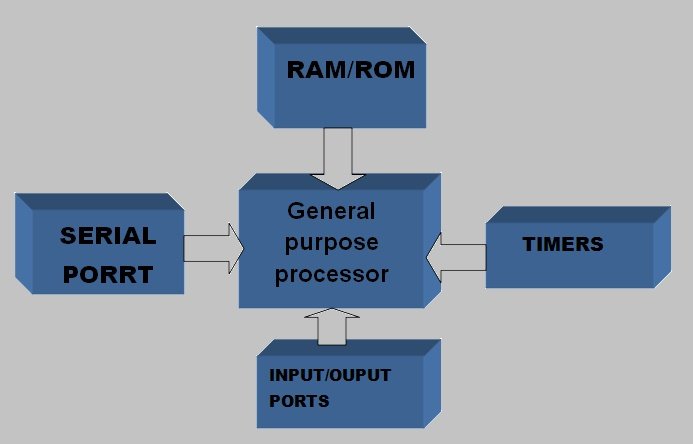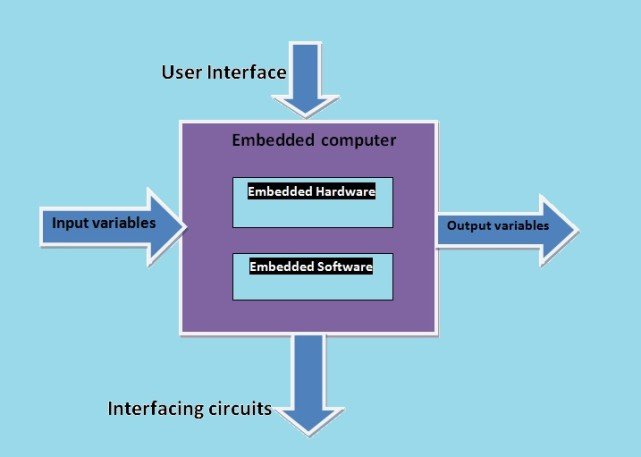Embedded systems are one of the fastest-growing fields in electrical engineering. Thousands of embedded system engineers work on different projects each day, producing more and more innovative technologies for the world. Embedded systems are used in many applications, ranging from domestic to industrial. Medical equipment, mobile phones, racing cars, smartphones, smart home systems, digital cameras, automated control of industrial machines, smart TVs, and almost everything in homes, offices, industries, and airplanes have embedded system applications. All these devices have a computer embedded in them. These computers use programming languages, with Linux operating systems commonly running on them.
What is an Embedded System?
Embedded systems, as the name suggests, involve embedding something into a system. In an embedded system, a computer is integrated into a system to perform a specific task. These systems are designed for special purposes and specific applications. For example, in a digital camera, a microcomputer is embedded to take pictures and perform other control functions through programmed instructions. Some embedded computers run on the Linux operating system and are programmed to perform specific tasks. Embedded systems serve different purposes for different individuals. For instance, one person may want to control the speed of a DC motor using a microcontroller, which represents a simple embedded system, while another individual may aim to create a smartphone with embedded processors. Therefore, embedded systems have diverse applications based on different needs. The main overview of embedded system architecture is outlined below.
Embedded Systems Computers
An embedded system is generally a computer, but its functions are less than those of general-purpose computers. This is because they are designed to perform specific tasks. Embedded system computers contain CPUs that run at slower speeds than general-purpose computers in order to save power. They have less memory, and the processors also run at lower speeds than general-purpose computers. In addition, embedded systems have software running inside them. Embedded software development is also a key part of embedded system development. Some embedded systems use only C and C++ programming languages, while others use embedded Linux systems, which means they have the Linux operating system running on them.
An embedded system uses both hardware and software to control and monitor the workings of many devices. Both hardware and software are essential components of embedded system projects.
Embedded System Architecture
Embedded system architecture refers to the fundamental structure and design of an embedded system, which plays a pivotal role in determining its performance, capabilities, and suitability for specific applications. Understanding the architecture is crucial for developers and engineers working on embedded systems as it influences hardware selection, software design, and system behavior. Here, we will delve into key concepts and considerations related to embedded system architecture.
Microcontrollers vs. Microprocessors:
Microcontrollers are integrated circuits that combine a processor core, memory, and input/output peripherals into a single chip. They are commonly used in embedded systems due to their compactness and cost-effectiveness.
Microprocessors, on the other hand, are standalone processing units without integrated peripherals. They are typically used in more complex embedded systems where customization and performance are essential.
Memory Hierarchy:
Embedded systems often have limited memory resources. Understanding the memory hierarchy, including RAM (Random Access Memory) and ROM (Read-Only Memory), is crucial for efficient program execution and data storage.
Flash memory is commonly used for non-volatile storage of program code and data in embedded systems.
Harvard vs. von Neumann Architecture:
Embedded systems may employ either the Harvard or von Neumann architecture.
Harvard architecture has separate memory spaces for program instructions and data, which allows for simultaneous fetching of instructions and data. This can improve execution speed but may require additional hardware.
von Neumann architecture uses a single memory space for both program instructions and data. While it is simpler, it can result in slower execution.
Single-core vs. Multi-core Processors:
The choice between single-core and multi-core processors depends on the performance requirements of the embedded system.
Single-core processors are suitable for simple tasks and applications with low processing demands.
Multi-core processors can handle parallel processing, making them ideal for applications requiring multitasking or real-time processing.
Bus Architecture:
The bus architecture defines how data and control signals are transferred between different components of the embedded system, including the CPU, memory, and peripherals.
Understanding the bus architecture is crucial for optimizing data transfer rates and minimizing bottlenecks.
System-on-Chip (SoC):
SoC refers to a compact design where all the necessary components of an embedded system, including CPU, memory, and peripherals, are integrated onto a single chip.
SoCs are commonly used in modern embedded systems, reducing the overall size, power consumption, and cost.
Customization and Scalability:
The architecture should allow for customization to meet the specific requirements of the embedded system. Scalability options, such as adding more memory or peripherals, should be considered for future upgrades or enhancements.
Understanding and selecting the appropriate architecture is a critical early step in the design of an embedded system. It lays the foundation for efficient hardware utilization and sets the stage for software development, ultimately impacting the performance, power efficiency, and overall success of the embedded system project.
Embedded System Hardware Components
As we have already mentioned above, embedded systems consist of both hardware and software. Embedded systems have the following hardware components:
- Central processing unit or microcontrollers.
- Power supply circuit.
- Interfacing circuit, like sensors and liquid crystal displays.
- ROM and RAM memory.
- Timers.
- Input circuits.
- Output circuits.
- Serial communication devices.
Central Processing Unit or Processor/Microcontroller
The central processing unit is the main component of an embedded system. It acts as the brain of the system and is programmed to perform specific tasks using programming languages. The CPU is an integrated chip in a computer that includes an arithmetic logic unit, a real-time clock, a stack pointer, a program counter, serial ports, internal interrupts, and external interrupts. However, the CPU cannot function alone and requires other peripherals to be connected to it. A microprocessor also has the following components attached to it.

- RAM
- ROM
- TIMERS
- Serial communications ports
- Input/output ports
On the other hand, a microcontroller is a complete single-chip integrated computer. It has built-in RAM, ROM, timers, input/output ports, serial communication ports, analog-to-digital converters, counters, and digital-to-analog converters, which make them ready-to-use single-chip integrated computers. A microcontroller can be easily interfaced with sensors and other interfacing circuits due to the built-in input/output ports. The following are famous families of microcontrollers.
- Microchip PIC microcontrollers
- ARM microcontrollers
- AVR microcontrollers
- MSP microcontrollers
- Motorola microcontrollers
- intel 8051 microcontrollers
Microcontrollers have a low cost, small memory, slow speed, and low power consumption compared to digital signal processors. Microcontrollers can be easily interfaced with analog and digital sensors to control and monitor data for data acquisition.
Embedded System Software Components
Embedded software developers are also a main part of embedded system development. If hardware is the body of an embedded system, then software is the soul of the embedded system. Many programming languages are used for embedded system development. In microcontroller-based projects, the C programming language is used mostly. Many languages have been developed for embedded systems, and each programming language may be more useful for specific applications. In other words, one language may be useful for control and monitoring-based projects, but it may not be useful for signal processing and conditioning-based embedded system projects. The following programming languages are used for embedded systems development.
- Hardware languages ( HDL and VHDL)
- Software languages ( C, C++, JAVA, Andriod, Linux)
- Data flow languages
- Hybrid languages
Embedded Hardware Peripherals
Embedded systems interface with the external world through sensors and transducers. Sensors may be of analog or digital type. As you know, microcomputers can only understand digital values. Analog-to-digital converters are used to interface analog sensors with embedded system processors and microcontrollers. Many microcontrollers have built-in analog-to-digital converters and digital-to-analog converters. For example, in a remote monitoring embedded system, you need to interface temperature sensors, light sensors, moisture sensors, and other sensors to read their values. All these sensors are analog sensors. So you must need an analog-to-digital converter. Embedded systems also communicate with external devices using the following features:
- UART Serial communication
- SPI
- USB
- I2C communication
- CAN ( Controller Area Network)
- Ethernet
- Digital and analog input/output ports
Types of Embedded Systems
Embedded systems are classified into two groups based on performance and functional requirements: those that use processors and those that use microcontrollers. It s can be divided into two types according to their usage.
- Based on the performance of microcontrollers.
- Based on the performance and functional requirements.
Based on the performance of microcontrollers, embedded systems are further classified into three groups:
- Small scale
- Medium-scale
- Large-scale
Based on the performance and requirements of embedded projects, embedded systems are classified into four groups:
- Real time embedded systems
- stand alone
- networked
- Mobile applications embedded software
Applications of Embedded Systems
Embedded systems have revolutionized numerous industries and continue to play a vital role in shaping the technological landscape of today. With their ability to integrate seamlessly into various devices and perform specific tasks efficiently, these systems have found wide applications in sectors such as healthcare, automation, entertainment, transportation, and more.
In the medical field, embedded systems have transformed patient care, diagnosis, and treatment processes. They are employed in medical devices, such as pacemakers, insulin pumps, and prosthetic limbs, to monitor vital signs, deliver medication, and provide enhanced mobility to individuals with physical disabilities. Embedded systems also contribute to the development of advanced imaging technologies like MRI and CT scanners, aiding in accurate and timely medical diagnoses.
Automation is another sector where embedded systems have made a significant impact. From industrial control systems to home automation solutions, these systems enable the efficient operation and management of various processes. Industrial robots rely on embedded systems to perform precision tasks, leading to enhanced productivity and reduced human error. Smart home devices like thermostats, security systems, and voice assistants leverage embedded systems to create connected and intuitive environments for homeowners.
The entertainment industry has also benefited greatly from embedded systems. Smart TVs, gaming consoles, and streaming devices incorporate these systems to deliver high-quality audio and video experiences. From streaming your favorite shows to interacting with virtual reality environments, embedded systems enrich our entertainment options and bring immersive experiences into our living rooms.
Transportation systems heavily rely on embedded systems for efficient and safe operations. In modern automobiles, embedded systems govern functions such as engine management, navigation, safety features, and entertainment systems. These systems help optimize vehicle performance, enhance driver comfort, and improve overall road safety.
Beyond these sectors, embedded systems find applications in a multitude of other areas. They are instrumental in the functioning of smartphones and wearable devices, enabling seamless communication, powerful computing capabilities, and numerous applications. Aviation industry relies on embedded systems to ensure smooth aircraft operations, including flight control, navigation, and passenger comfort.
Projects
A list of the latest embedded system final year projects is given below:
- Home control system through voice.
- Real-time monitoring of electricity to prevent theft.
- Smart energy billing system.
- Smart grid monitoring system.
- Smart grid station.
- Real-time accident protection using GSM.
- Remote monitoring system using GSM and PIC microcontroller.
- Smart grid management and visualization.
Related content:


